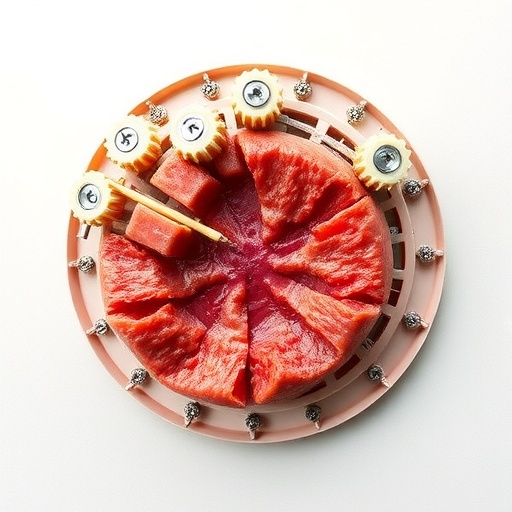In a groundbreaking study published in Nature, researchers unveil how mechanical confinement fundamentally alters melanoma cells by orchestrating a complex interplay between the cytoskeleton, nucleus, and associated molecular machinery. The findings illuminate the pivotal role of the microtubule (MT) cytoskeleton and its acetylated perinuclear network in regulating the nuclear protein HMGB2, a key effector in phenotypic plasticity and cellular response to mechanical stress. This research not only deepens our understanding of cellular biomechanics but also opens new avenues for targeted cancer therapies that manipulate physical microenvironments.
The investigation centered on the A375 melanoma cell line, where HMGB2 upregulation was observed as a direct consequence of mechanical confinement. The authors posited that force transmission through the perinuclear acetylated tubulin network could be a critical upstream event triggering nuclear HMGB2 enrichment. To dissect this hypothesis, stable A375 cell lines with CRISPR-mediated HMGB2 knockouts (HMGB2^KO) were generated, revealing that the acetylated tubulin network remained intact even when HMGB2 was absent. This pivotal observation established that the perinuclear acetylated microtubules operate upstream of HMGB2 accumulation, rather than vice versa.
Pharmacological modulation of tubulin dynamics underscored the significance of microtubule stability in HMGB2 regulation. Treatment with the HDAC6 inhibitor tubacin, known to increase tubulin acetylation, led to a dramatic enhancement in HMGB2 nuclear levels and accelerated accumulation rates in mechanically confined cells. Intriguingly, these effects were mimicked by paclitaxel (Taxol), a drug that stabilizes microtubules by binding β-tubulin without altering acetylation status. This parallel response suggested that the mechanical stabilization of MTs, rather than acetylation per se, underlies the HMGB2 upregulation observed under confinement.
To refine their understanding of the acetylated tubulin network’s role, the researchers employed nocodazole, a potent microtubule depolymerizing agent. While nocodazole typically disrupts MT arrays, the resistant perinuclear acetylated tubulin cage persisted in treated cells. Surprisingly, HMGB2 levels remained unchanged under these conditions, affirming that perinuclear acetylated microtubules are not solely responsible for HMGB2 enrichment. Additionally, knockout of ATAT1, the enzyme catalyzing tubulin acetylation, failed to impede HMGB2 accumulation, further highlighting that acetylated tubulin contributes to but is not strictly necessary for this response. These findings hint at functional redundancy or compensatory mechanisms within the cytoskeletal architecture.
Seeking other effectors interacting with HMGB2, the team conducted TurboID proximity labeling proteomics, revealing an intriguing association with nesprin 2, a known linker of nucleoskeleton and cytoskeleton (LINC) complex protein. The LINC complex integrates cytoskeletal forces with nuclear structures, functioning as a mechanical hub. The enrichment of nesprin 2 in proximity to HMGB2 suggested that this complex mediates force transmission necessary for HMGB2 regulation during confinement. Subsequent experiments showed that nesprin 2 was itself upregulated by confinement and that siRNA-mediated knockdown of SYNE2 (the nesprin 2 gene) abrogated both HMGB2 accumulation and the perinuclear tubulin network, confirming functional interdependence.
The LINC complex is integral to nuclear mechanics, particularly in tuning nuclear stiffness through connections to the nuclear lamina. Indeed, lamin A/C protein levels surged approximately threefold in response to confinement, indicative of nuclear lamina remodeling. Atomic force microscopy corroborated these findings by demonstrating heightened nuclear stiffness in confined melanoma cells. Together, these observations illustrate a coordinated cellular strategy: remodeling of both cytoskeletal and nuclear components reinforces the cell’s structural resilience to external mechanical forces.
This adaptive remodeling ultimately culminates in the upregulation of HMGB2, a DNA-binding protein implicated in chromatin organization and transcriptional regulation. The enhanced nuclear HMGB2 may drive phenotypic plasticity, facilitating melanoma cells to endure and thrive under physical constraints characteristic of the tumor microenvironment, such as dense extracellular matrices or tight tissue spaces. This mechanotransductive pathway represents a crucial nexus linking extracellular mechanical signals to nuclear gene regulatory networks.
The meticulous dissection of microtubule dynamics, acetylation states, and their interplay with LINC complex proteins unveils a nuanced understanding of how mechanical force translates into biochemical signals modulating nuclear function. The research highlights that while acetylated microtubules form a significant structural element in force transmission, their presence is neither absolutely required nor sufficient for HMGB2 upregulation, underscoring the complexity of intracellular mechanosensing networks.
Furthermore, the identification of nesprin 2 as a critical mediator bridges cytoskeleton-nucleus communication, reinforcing the concept that mechanical properties of the cell are integrated across compartments. This integration modulates not only nuclear stiffness but also chromatin dynamics, as implied by altered HMGB2 levels, ultimately affecting gene expression programs that facilitate cancer cell adaptability and survivability.
Beyond fundamental cell biology, these discoveries offer translational potential. Targeting components of the cytoskeletal network or LINC complex may disrupt the mechanical signaling pathways that foster malignant plasticity, presenting innovative therapeutic strategies. Drugs like tubacin or Taxol, already approved or under investigation, may be repurposed to modulate tumor biomechanics and nuclear responses, potentially improving treatment outcomes.
Future research avenues prompted by this study include delineating the molecular downstream targets of HMGB2 in the context of mechanical stress and defining how these transcriptional changes affect metastatic potential. Additionally, exploring the reversibility of nuclear and cytoskeletal remodeling could shed light on phenotypic plasticity’s temporal dynamics during cancer progression.
In conclusion, this multifaceted study reveals how melanoma cells sense and respond to mechanical confinement through an orchestrated restructuring of cytoskeletal elements, nuclear components, and associated proteins, culminating in phenotypic adaptation. By decoding the biomechanical signaling pathways that govern HMGB2 upregulation and nuclear stiffening, the work charts new territory at the intersection of cell mechanics, nuclear biology, and cancer phenotypic plasticity, promising to influence both basic science and clinical oncology.
Subject of Research: Mechanical regulation of cellular phenotypic plasticity in melanoma
Article Title: Mechanical confinement governs phenotypic plasticity in melanoma
Article References:
Hunter, M.V., Joshi, E., Bowker, S. et al. Mechanical confinement governs phenotypic plasticity in melanoma. Nature (2025). https://doi.org/10.1038/s41586-025-09445-6
Image Credits: AI Generated




